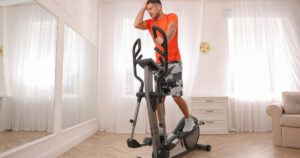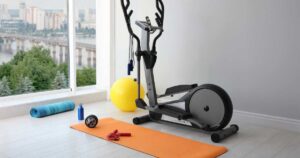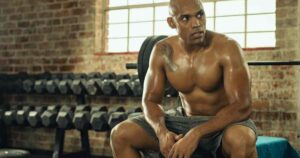List of 5 must-try exercises that start with the letter z (How To Perform, common mistakes to avoid, tips, Intensity level, Muscles Worked, Average Calorie Burn, safety precautions)
Greetings, fitness lover! Have you ever wondered why exercise is so important? It’s not just about fitting into those skinny jeans or getting that summer beach body.
Exercise has countless benefits for your physical and mental health, and the best part is, that you can experience these benefits by including just a little bit of exercise into your daily routine.
In this amazing post, We’re going to present you with 5 must-try exercises that start with the letter Z. From Zottman Curls to Zesty Zumba Lunges, these workouts will surely spice up your fitness journey.
So, lace up your shoes, grab some water, and get ready to dive into our list of 5 amazing exercises that start with the letter Z.
5 Must-Try Exercises That Start With The Letter Z
- Zottman Curls
- Zesty Zumba Lunges
- Zercher Squats
- Zottman Preacher Curls
- Z-Press
Zottman Curls
Zottman curls are a versatile exercise that targets multiple muscles in the upper body, specifically the biceps, forearms, and shoulders. This compound movement combines both hammer and supine grip variations to provide a comprehensive workout.
How To Perform:
- Start by standing upright with a dumbbell in each hand, palms facing your thighs.
- Keep your core engaged and maintain proper posture throughout the exercise.
- Begin the movement by curling the dumbbells up towards your shoulders, while keeping your elbows close to your sides.
- As you reach the top of the curl, rotate your wrists so that your palms are now facing away from you.
- Slowly lower the weights back down to the starting position, making sure to control the movement and avoid using momentum.
- Repeat for the desired number of repetitions.
Common Mistakes to Avoid While Doing Zottman Curls:
- Using too much weight: One common mistake many people make when performing Zottman curls is using weights that are too heavy for them.
- While it’s important to challenge yourself, lifting weights that are too heavy can compromise your form and increase the risk of injury.
- Start with lighter weights and gradually increase as you build strength.
- Swinging the arms: Another mistake to avoid is swinging your arms during the exercise.
- This not only reduces the effectiveness of the movement but also puts unnecessary strain on your shoulders and wrists.
- Keep your upper body stable and focus on controlled movements throughout each repetition.
- Neglecting proper grip technique: Grip plays a crucial role in Zottman curls, yet it’s often overlooked.
- Make sure you have a firm grip on the dumbbells, with your palms facing up during the curl portion and then rotating them downward during the reverse curl phase.
- Relying only on momentum: Many people tend to rely on momentum rather than engaging their muscles fully during Zottman curls.
- Remember to emphasize slow and controlled movements, focusing on contracting your biceps during each curl and maintaining tension throughout.
- Not maintaining proper posture: Poor posture can significantly affect your form while performing Zottman curls, leading to ineffective results or even injury over time.
- Stand tall with your chest lifted, shoulders back, and core engaged throughout the exercise.
- Varying speed or range of motion haphazardly: Another mistake individuals commonly make is varying their speed or range of motion haphazardly while performing Zottman curls.
- Maintain consistent speed throughout each repetition while ensuring full range of motion at both ends – fully extending at elbows at the starting position; and squeezing biceps at the top position.
Tips to Maximize the Effectiveness of Zottman Curls:
- Maintain proper form: One of the key aspects to ensure effective Zottman curls is maintaining a correct form throughout the exercise. Keep your back straight, shoulders relaxed, and core engaged. Avoid swinging or using momentum to lift the weights.
- Start with lighter weights: If you’re new to Zottman curls, it’s best to start with lighter weights until you become comfortable with the movement and can perform it correctly. Gradually increase the weight as you gain strength and confidence.
- Focus on controlled movements: Slow and controlled movements are vital for maximizing results during Zottman curls. This ensures that your muscles are properly activated and prevents any unnecessary strain or injury.
- Squeeze at the top: When lifting the dumbbells during a Zottman curl, make sure to squeeze your biceps at the top of each repetition before slowly lowering them down again. This will help in fully engaging your muscles and promoting muscle growth.
- Train both arms equally: It is crucial to train both arms equally while performing Zottman curls to avoid muscular imbalances and promote overall strength development.
- Pay attention to any discrepancies in strength between your dominant and non-dominant arm, adjusting accordingly if needed.
- Take rest days: Allow ample time for recovery between Zottman curl workouts by including rest days into your routine. This will give your muscles sufficient time to repair themselves, preventing overuse injuries and ensuring optimal results from each workout session.
Intensity level:
When it comes to intensity, Zottman curls can be adjusted to suit your fitness level and goals. The intensity of Zottman curls can be increased by using heavier weights or increasing the number of repetitions.
To maximize the intensity of Zottman curls, focus on maintaining proper form throughout the exercise. Keep your core engaged, maintain a slight bend in your knees, and avoid swinging or using momentum to lift the weights.
Muscle worked:
- The main muscle worked during Zottman curls is the biceps brachii. This is the large muscle on the front of your upper arm, responsible for flexing your elbow joint.
- In addition to the biceps brachii, Zottman curls also engage other muscles in your arms. The brachialis and brachioradialis are involved. These muscles help with forearm flexion and pronation, respectively.
- Zottman curls activate your deltoids or shoulder muscles. The anterior (front), medial (middle), and posterior (rear) deltoid heads all play a role in stabilizing and supporting your upper arm throughout the movement.
Average Calorie Burn:
On average you can expect to burn around 100 to 150 calories in a 30-minute session of Zottman curls.
It’s important to note that this estimate is just a rough guideline and individual results may vary. Factors such as your overall fitness level and muscle mass can influence your calorie burn rate.
Additionally, including other exercises that start with the letter z in your routine or performing high-intensity interval training (HIIT) can further increase your overall caloric consumption.
To get a more accurate measure of your calorie burn during Zottman curls, consider using wearable fitness trackers or heart rate monitors that calculate calories burned based on heart rate data.
SEE ALSO: 5 MUST-TRY EXERCISES THAT START WITH K
Zesty Zumba Lunges
Zesty Zumba Lunges are a fun and energetic exercise that can help strengthen your legs and improve your cardiovascular fitness. Here are the steps to do Zesty Zumba Lunges:
How To Perform:
- Start by standing with your feet shoulder-width apart, toes pointing forward.
- Take a big step forward with your right foot, bending both knees into a lunge position.
- As you lunge, bring your left arm across your body towards the right side of your waist while extending your right arm out to the side.
- Push off with your right foot and return to the starting position.
- Repeat on the other side, stepping forward with your left foot and bringing your right arm across your body.
Common Mistakes to Avoid While Doing Zesty Zumba Lunges:
- Overextending the Knee: Another mistake is overextending the knee when performing a lunge. This occurs when you push too far forward with your front leg, causing excessive stress on the knee joint.
- Instead, focus on keeping a 90-degree angle on both knees by stepping out just far enough that your front thigh is parallel to the ground.
- Forgetting to Engage Core Muscles: Many people forget to engage their core muscles while doing Zesty Zumba lunges. Your core provides stability and helps maintain proper alignment throughout the exercise.
- Remember to activate your abdominal muscles by drawing them in towards your spine before starting each lunge.
- Rushing Through Repetitions: A common error is rushing through each lunge without focusing on proper technique or control. It’s important to perform each rep slowly and mindfully, paying attention to how your body feels throughout the movement.
- Incorrect Foot Placement: Pay close attention to where you place your feet during Zesty Zumba lunges. Avoid letting one foot drift too far forward or backward, as this can throw off balance and compromise form.
- Not Warming Up Properly: Skipping a proper warm-up before diving into lunges can lead to muscle imbalances and an increased risk of injury.
- Take time for some dynamic stretches and light cardio exercises like jumping jacks or jogging in place to prepare your body for the workout ahead.
Tips to Maximize the Effectiveness of Zesty Zumba Lunges:
- Focus on Form: Maintain proper form throughout Zesty Zumba Lunges. Keep your chest lifted, and shoulders relaxed, and engage your core muscles. Prevent unnecessary strain on your joints.
- Start Slowly: If new to Zesty Zumba Lunges, start with lighter weights or no weights. Focus on mastering the movement before adding additional resistance.
- Mind Your Balance: Distribute your weight evenly between both legs as you lunge forward. Avoid leaning too far forward or backward to prevent balance issues and reduce the risk of injury.
- Engage Your Glutes: Squeeze your glute muscles as you push back up from the lunge position. Maximize the effectiveness of each lunge and give your glutes a good workout.
- Breathe Properly: Inhale as you lower into the lunge position and exhale as you return to standing. Focus on deep breaths to oxygenate your muscles and maintain energy throughout your workout.
- Listen to Your Body: Pay attention to how your body feels during each set of lunges. Stop immediately and reassess your form or modify the exercise if needed in case of discomfort or pain.
Intensity level:
Zesty Zumba Lunges are a high-intensity exercise that will get your heart pumping and muscles working. The intensity level of this exercise can be adjusted based on your fitness level and goals.
The intensity of this exercise can be increased by adding weights or increasing the speed and range of motion during each lunge. You can also modify the tempo or add jumps to make it more challenging.
Muscle worked:
- Quadriceps: The quadriceps muscles, located on the front of your thighs, heavily engage during Zesty Zumba Lunges. They work to extend the knee joint and maintain balance during the lunge movements.
- Glutes: Your gluteal muscles, including the gluteus maximus, medius, and minimus, play a significant role. They assist in hip extension and stabilization, adding power to your Zesty Zumba Lunges.
- Hamstrings: The back of your thighs is primarily targeted by Zesty Zumba Lunges. Hamstrings are involved in knee flexion, contracting to control movements such as lunging backward or performing jumping lunges.
- Calves: The calf muscles act as stabilizers during these lunges. They support your body weight and contribute to maintaining balance throughout the exercise.
- Core Muscles: While not directly targeted, engaging your core is crucial. It helps in maintaining stability and proper form during each lunge movement.
Average Calorie Burn:
The average calorie burn during a session of Zesty Zumba Lunges can vary depending on factors such as intensity, duration, and individual body composition.
On average, you can expect to burn around 300-500 calories in a 45-minute class. Keep in mind that everyone’s calorie burn will be different based on their fitness level and the effort put into each movement. It’s important to listen to your body and adjust the intensity accordingly.
Zercher Squats
Zercher squats are a challenging and effective exercise that targets multiple muscle groups in the body. This unique variation of the traditional squat is named after its creator, Ed Zercher, who developed it in the 1930s.
How To Perform:
- Start by positioning a barbell on the squat rack at about waist height. Stand with your feet shoulder-width apart and place yourself in front of the bar.
- Reach down and grasp the bar with an underhand grip, keeping your hands slightly wider than shoulder-width apart.
- Lift the bar off the rack and bring it up to rest on your forearms, just below your elbows. Make sure to keep your chest lifted and core engaged throughout the exercise.
- Take a step back from the squat rack and position your feet slightly wider than hip-width apart, toes pointing slightly outward.
- Begin lowering into a squatting position by pushing your hips back and bending at the knees. Keep your weight distributed evenly between both heels as you lower down.
- Continue descending until your thighs are parallel to the ground or just below, making sure to maintain proper form with a neutral spine and engaged core.
- Push through your heels to rise back up to the starting position, fully extending your hips and knees at the top of each rep.
- Repeat for the desired number of repetitions, focusing on maintaining control throughout each movement.
Common Mistakes to Avoid While Doing Zercher Squats:
- Poor form: One common mistake is not maintaining proper form during Zercher squats. Keep your back straight, chest up, and knees in line with your toes throughout the movement. Avoid rounding your back or letting your knees cave inwards.
- Using too much weight: Another mistake is using weights that are too heavy for you. This can lead to compromised form and increase the risk of injury. Start with lighter weights and gradually increase as you build strength and confidence.
- Not engaging the core: Neglecting to engage your core muscles during Zercher squats can put unnecessary strain on your lower back. Make sure to brace your abs and keep them tight throughout the exercise.
- Rushing through the exercise: Many people make the mistake of rushing through their reps without focusing on proper technique or control. Take it slow, feel each contraction, and maintain good form throughout each repetition.
- Neglecting warm-up sets: Skipping warm-up sets is a common error that can lead to muscle strains or other injuries. Always start with a few light sets before progressing to heavier weights.
- Overtraining: Overdoing it on Zercher squats can be detrimental rather than beneficial for your progress. Give yourself adequate rest days between workouts to allow for recovery and muscle growth.
Tips to Maximize the Effectiveness of Zercher Squats:
- Warm up properly: Before diving into your Zercher squat routine, warm up your muscles and joints. Include dynamic stretches and light cardio exercises to activate the targeted muscle groups.
- Master the setup: The key to a successful Zercher squat is getting the setup right. Position the barbell in the crook of your elbows, keeping your forearms parallel to the ground. Maintain a tight grip on the bar without straining your wrists.
- Engage your core: To maintain stability during Zercher squats, engage your core muscles throughout each rep. This will help you maintain proper form and prevent unnecessary strain on your lower back.
- Focus on depth: Aim for a full range of motion by squatting down until your thighs are parallel or below parallel with the floor. Going too shallow can limit muscle activation and hinder progress.
- Breathe correctly: Don’t forget about proper breathing techniques during Zercher squats! Inhale deeply before descending into the squat position, then exhale forcefully as you push through the concentric phase.
- Gradually increase weight: Like any exercise, gradually increasing resistance is essential for progress with Zercher squats. Add weight incrementally over time while maintaining good form to challenge yourself and continue making gains.
Intensity level:
The intensity level of Zercher squats can be quite high, especially if you’re using heavy weights. This exercise requires a significant amount of core stability and upper body strength to hold the barbell in the crooks of your elbows while performing the squat movement.
The added challenge of holding the weight in this position increases the demand on your muscles and elevates your heart rate.
When it comes to determining the intensity level of an exercise, factors such as load (weight used), volume (sets and reps), tempo (speed at which you perform each rep), and rest periods between sets all play a role.
By manipulating these variables, you can adjust the intensity level to suit your fitness goals. To increase the intensity of Zercher squats, consider increasing either the weight or repetitions performed.
Muscle worked:
- Quadriceps: One major muscle group targeted during Zercher squats is the quadriceps. As you lower into a squat position. These muscles contract to control your descent and then push you back up to standing.
- Hamstrings: The hamstrings also play a significant role as they work in conjunction with the quads to stabilize and support your knee joints.
- Glutes: Zercher squats activate the glutes or buttocks muscles. These powerful muscles are responsible for hip extension when you stand up from a squatting position. Engaging them during Zercher squats helps improve overall lower body strength and stability.
- Erector Spinae Muscles: The erector spinae muscles of the lower back are engaged during Zercher squats as well. They help to maintain an upright posture and support the weight of the barbell across your elbows.
- Biceps: While primarily considered an arm exercise, Zercher squats require significant bicep engagement. Necessary to hold onto the barbell securely throughout each rep.
Average Calorie Burn:
On average it is estimated that performing Zercher squats can help you burn between 200 to 400 calories per hour.
This calorie burn is attributed to the compound nature of the exercise, which engages large muscle groups such as the quadriceps, hamstrings, glutes, core muscles, and upper back.
By working these major muscle groups simultaneously, your body requires more energy consumption resulting in increased calorie burn.
Moreover, Zercher squats also have a higher metabolic demand compared to traditional squat variations due to the unique positioning of the barbell in front of your body. This added resistance increases overall exertion levels and subsequently boosts calorie consumption.
SEE ALSO: 6 MUST-TRY EXERCISES THAT START WITH P
Zottman Preacher Curls
Zottman Preacher Curls are a variation of the traditional preacher curl exercise. This exercise specifically targets the biceps, forearms, and brachialis muscles. It is an effective way to build strength and definition in these areas.
How To Perform:
- Start by positioning yourself on a preacher curl bench, with your feet firmly planted on the ground and your arms extended over the pad.
- Hold a dumbbell in each hand with an underhand grip (palms facing up), ensuring that your elbows are fully extended.
- Slowly curl the weights towards your shoulders, keeping your upper arms stationary and squeezing your biceps at the top of the movement.
- Once you reach the top position, rotate your wrists so that they face downward (pronated grip).
- Lower the dumbbells back down to the starting position using a controlled motion, again keeping your upper arms stationary.
- Repeat for the desired number of repetitions, focusing on maintaining proper form throughout each rep.
Common Mistakes to Avoid While Doing Zottman Preacher Curls:
When it comes to Zottman Preacher Curls, there are a few common mistakes that people often make. Avoiding these mistakes can help you get the most out of this exercise and prevent injuries.
- Using Excessive Weight: One mistake to avoid is using too much weight. It’s important to start with a weight that allows you to maintain proper form throughout the movement.
- Using excessive weight not only compromises your form but also increases your risk of straining or injuring your muscles.
- Swinging Dumbbells: Another common mistake is swinging the dumbbells during the curling phase. This momentum takes away from the effectiveness of the exercise and puts unnecessary strain on your joints.
- Neglecting Grip Strength: Many people tend to neglect their grip strength while performing Zottman Preacher Curls. Make sure to have a firm and secure grip on the dumbbells throughout each repetition. Weak grips can lead to dropped weights or reduced muscle engagement.
- Improper Positioning: Improper positioning is another mistake commonly seen during this exercise. Ensure that your upper arms remain firmly positioned against the preacher bench pad throughout each rep.
- Avoid allowing them to move forward or lift off from the pad as this reduces tension in targeted muscles.
Tips to Maximize the Effectiveness of Zottman Preacher Curls:
- Maintain proper form: One of the key factors in getting the most out of your Zottman preacher curls is to maintain proper form throughout the exercise. Keep your back straight, shoulders relaxed, and elbows tucked in close to your body.
- Use a controlled tempo: Avoid rushing through the movement and instead focus on using a slow and controlled tempo. This will ensure that you are effectively targeting the muscles involved and reduce the risk of injury.
- Grip variation: Experiment with different grip variations during Zottman preacher curls to target different muscle groups. For example, using an underhand grip will engage more of your biceps, while an overhand grip places greater emphasis on your forearms.
- Gradually increase weight: As with any exercise, it’s important to gradually increase the weight as you become stronger and more comfortable with the movement. This progressive overload will help stimulate muscle growth over time.
- Don’t neglect the eccentric phase: The eccentric or lowering phase of Zottman preacher curls is just as important as lifting weights up toward your shoulders. Control the descent by resisting gravity rather than letting momentum take over.
Intensity level:
The intensity of this exercise can be adjusted depending on factors such as the weight used, the number of repetitions performed, and rest intervals between sets. Beginners should start with lighter weights and gradually increase as they build strength and confidence.
To maximize the intensity of Zottman Preacher Curls, focus on maintaining proper form throughout each repetition. Keep your upper arms firmly against the preacher bench pad and avoid using momentum or swinging your body during the movement.
Muscle worked:
- In addition to targeting the biceps, this exercise also engages several other key muscles. One of these muscles is the brachialis, which lies underneath the biceps and helps with forearm flexion.
- By including Zottman Preacher Curls into your workout routine, you can effectively strengthen and develop both your biceps and brachialis.
- This exercise also activates the brachioradialis muscle, which runs along the forearm. The brachioradialis assists with both elbow flexion and pronation of the wrist.
- By engaging multiple muscles simultaneously, Zottman Preacher Curls provide a comprehensive upper-body workout. It allows you to target specific areas while promoting overall strength development.
Average Calorie Burn:
On average for someone weighing around 155 pounds (70 kg), performing Zottman Preacher Curls for about 30 minutes may burn approximately 112 to 150 calories. Remember that these numbers can vary depending on individual factors.
While strength training exercises like Zottman Preacher Curls may not have as high of a calorie burn compared to cardiovascular exercises like running or cycling, they still play an essential role in building muscle mass and increasing overall metabolism.
SEE ALSO: HOW LONG DOES IT TAKE TO WALK 6 MILES?
Z-Press
Z-Press is a challenging exercise that targets the shoulders, upper back, and core muscles. It involves pressing a barbell or dumbbell overhead while sitting on the ground with legs extended straight out in front.
How To Perform:
- Start by sitting on a bench with your legs extended in front of you and your feet flat on the ground. Hold a barbell with an overhand grip, hands slightly wider than shoulder-width apart.
- Engage your core and press the barbell overhead until your arms are fully extended. Keep your elbows locked out and maintain a neutral spine throughout the movement.
- Lower the barbell back down to the starting position, allowing it to lightly touch your chest before pressing it back up again. Focus on using controlled movements rather than relying only on momentum.
- Repeat for the desired number of repetitions, ensuring proper form is maintained throughout each rep.
- As you progress, you can increase the weight or try variations such as using dumbbells or kettlebells instead of a barbell.
Common Mistakes to Avoid While Doing Z-Press:
- Poor Form: One of the most common mistakes people make while performing Z-Press is having poor form. It’s essential to maintain proper posture throughout the exercise, keeping your back straight and core engaged.
- Avoid leaning forward or arching your back excessively.
- Overdoing Weight: Another mistake is using too much weight without focusing on proper technique. Start with lighter weights until you feel comfortable with the movement and gradually increase as your strength improves.
- Neglecting Warm-up: Skipping a warm-up before starting Z-Press can lead to injuries and decreased performance. Always take a few minutes to warm up your shoulders, wrists, and upper body before diving into the exercise.
- Rushing Through Repetitions: Many people tend to rush through their reps, sacrificing form and control for speed. Remember that quality over quantity is crucial here – focus on performing each repetition slowly and controlled, feeling the muscle engagement throughout.
- Lack of Stability: Maintaining stability during Z-Press is vital for targeting the intended muscles effectively. Avoid swinging or using momentum from other body parts to lift the weight; instead, concentrate on stabilizing your core and upper body.
- Ignoring Breathing Technique: Pay attention to your breathing pattern while doing Z-Press; exhale as you press the weight overhead and inhale as you lower it down again. This helps stabilize your core muscles and enhances overall performance.
Tips to Maximize the Effectiveness of Z-Press:
- Focus on Proper Form: When performing the Z-Press, it’s crucial to maintain proper form throughout the movement. Keep your back straight, engage your core, and avoid leaning or arching backward.
- Start with Light Weights: If you’re new to the Z-Press exercise, start with lighter weights until you feel comfortable and confident with the movement. Gradually increase the weight as you build strength and stability.
- Engage Your Shoulders: To maximize results from the Z-Press, focus on engaging your shoulders throughout each repetition. Imagine pushing through the resistance as you press overhead.
- Control the Descent: As important as lifting is controlling down movements during a workout session like this one called “Z-press”. Maintain control as you lower the weight back down to the starting position to effectively target your shoulder muscles.
- Breathe Properly: It’s essential to breathe properly during any exercises that start with the letter z, including Z-Presses. Inhale deeply before initiating each rep and exhale forcefully when pressing up towards full extension.
- Including Variation: Don’t be afraid to mix things up by including different variations of the Z-Press into your routine, such as seated or standing versions—to challenge different muscle groups within your shoulders and upper body.
Intensity level:
The intensity level of Z-Press can vary depending on various factors such as the weight used, rep range, and individual strength levels. This exercise that starts with the letter z is renowned for its ability to target the shoulders and upper body muscles effectively.
To increase or decrease the intensity level of Z-Press, you can adjust variables such as load (weight), tempo (speed), and rest periods between sets. By increasing these variables gradually over time, you can continually challenge yourself and progress towards higher levels of intensity.
Muscle worked:
- Shoulders: The Z-Press heavily activates the deltoid muscles, which are responsible for shoulder abduction and flexion. It specifically targets the anterior (front), medial (side), and posterior (rear) deltoids, helping to develop well-rounded shoulder strength.
- Upper Back: During the Z-Press, your upper back muscles such as the rhomboids and trapezius work hard to stabilize your spine and maintain an upright posture throughout the movement. This leads to improved posture and a stronger upper body overall.
- Core: Maintaining proper form during the Z-Press requires significant core engagement. Your abs, obliques, and deep stabilizing muscles like the transverse abdominis work together to keep your torso stable while pressing overhead.
Average Calorie Burn:
On average a person weighing around 155 to 185 pounds can expect to burn approximately 90 to 130 calories during a 30 minute session of moderate intensity strength training.
To maximize calorie burn during Z-Press workouts, focus on maintaining proper form throughout each repetition and gradually increasing the weight or resistance over time. Additionally, including high-intensity interval training (HIIT) techniques in your routine can further enhance calorie burn.
FAQs
Do zottman curls work forearms?
Zottman curls, a variation of traditional bicep curls, are an excellent exercise for targeting not only your biceps but also your forearms. This compound movement engages multiple muscle groups simultaneously, making it a fantastic choice if you want to strengthen and tone your arms.
The beauty of Zottman curls lies in their ability to work both the flexor and extensor muscles of the forearm. As you curl the weight up towards your shoulders with an underhand grip, your biceps are primarily activated.
However, as you slowly lower the weight back down with an overhand grip, your forearms come into play to control the descent.
Are 30 minutes of Zesty Zumba lunges good for weight loss?
Many people wonder if spending just 30 minutes doing these zesty Zumba lunges can actually help with weight loss.
The short answer is yes! Any form of physical activity that gets your heart rate up and burns calories can contribute to weight loss.
Zesty Zumba lunges are no exception. With its fast-paced movements and continuous flow, this workout can help you burn a significant amount of calories in just half an hour.
Remember that while zesty Zumba lunges can be beneficial for weight loss, they should be combined with other forms of exercise as well as a balanced diet for optimal results.
Are zercher squats bad for your arms?
Are zercher squats bad for your arms? This is a common question among fitness enthusiasts who are looking to add variety to their leg workouts.
Zercher squats are a type of squat exercise where the barbell is held in the crook of your elbows, rather than on your upper back like traditional back squats.
One concern that some people have about zercher squats is whether they put too much strain on the arms. After all, you’re supporting the weight of the barbell with your forearms and biceps during this exercise.
However, when performed correctly and with proper form, zercher squats can actually be beneficial for strengthening and building arm muscles.
The unique positioning of the barbell in front of your body forces your arms to work harder to stabilize and support the weight. This can lead to increased strength gains in both your forearms and biceps over time.
Additionally, because you’re engaging more muscles during this exercise compared to traditional back squats, it can also help improve overall upper body strength.
Do zottman preacher curls make your biceps bigger?
Do zottman preacher curls make your biceps bigger? This is a question that often comes up in the fitness world. Zottman preacher curls are an exercise that targets both the biceps and forearms, making it a popular choice for those looking to build strength and size in these areas.
When you perform Zottman preacher curls, you start with your palms facing up and your arms resting on a preacher’s bench.
As you curl the weight up towards your shoulders, you rotate your wrists so that your palms end up facing down at the top of the movement. This rotation engages not only the biceps but also the forearms.
By including this rotational movement into traditional preacher curls, zottman preacher curls provide additional stimulus to the muscles of both the upper arm and forearm. This can lead to increased muscle growth and definition in these areas over time.
Is Z-Press better than Shoulder Press?
The debate between the z-press and the shoulder press has been ongoing among fitness enthusiasts. Both exercises target the shoulders, but which one is better? Well, it ultimately depends on your individual goals and preferences.
If you’re looking to develop strong stabilizer muscles in your core while working out your shoulders, then incorporating z-presses into your routine can be beneficial. This exercise challenges both upper-body strength and core stability simultaneously.
However, if building overall upper body strength and size is your main goal, then traditional shoulder presses might be more suitable for you. The ability to use additional weight due to increased stability allows for greater overload on the targeted muscles.
There’s no definitive answer as to which exercise is better because it depends on what specific goals you have set for yourself. Consider consulting with a fitness professional who can assess your needs and help tailor a workout plan that aligns with them.
Wrapping Up
So, fitness lover! Including a variety of exercises that start with the letter z in your fitness routine is essential for achieving overall strength, endurance, and flexibility.
While it may seem challenging to find exercises that start with the letter Z, we’ve highlighted 5 must-try exercises that start with the letter z that can add some zest to your workouts.
From Zottman Curls to Zesty Zumba Lunges, each exercise offers unique benefits and targets different muscle groups.
But always remember to follow proper form and technique when performing these movements to maximize their effectiveness and minimize the risk of injury.









